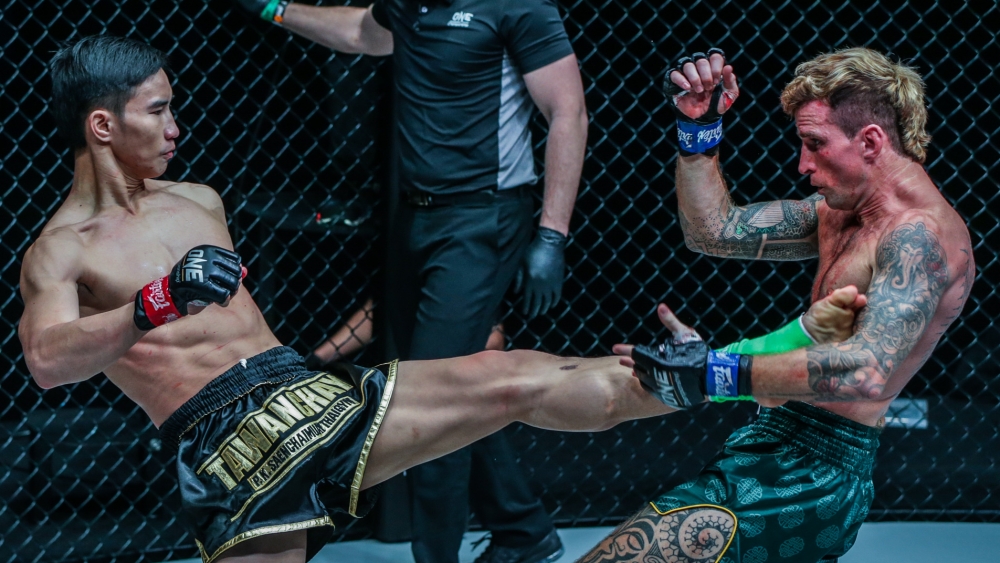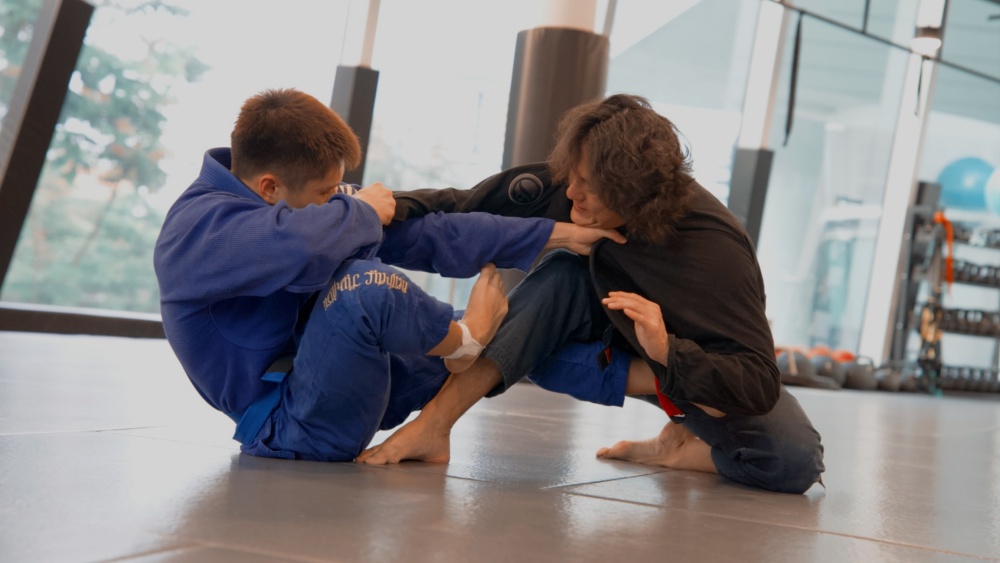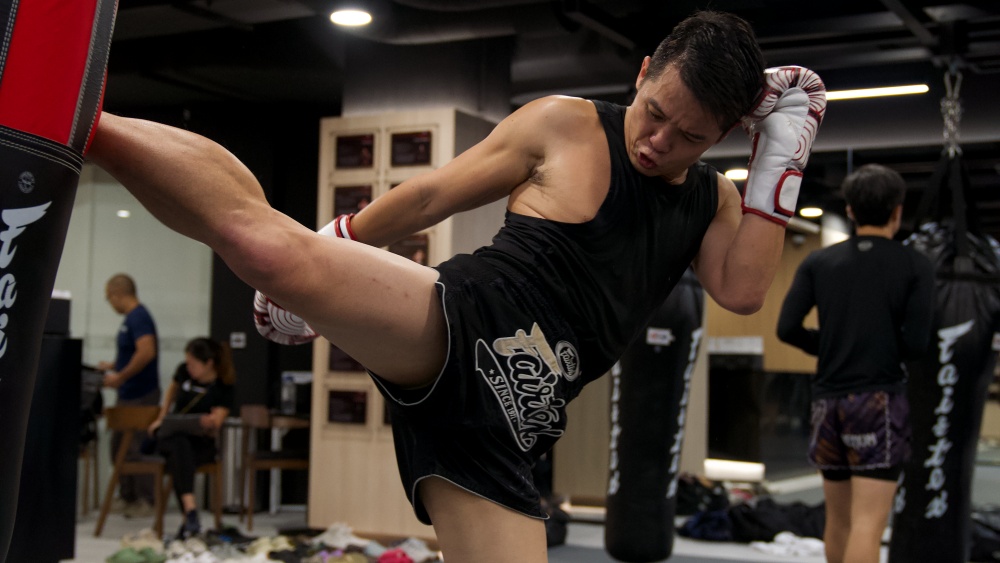Have you ever struggled to corner an evasive opponent in the ring? Or are you sick of getting kept out of striking range by a taller opponent’s teep? Whenever you need to close distance quickly and safely, the Muay Thai hop is a great technique to have in your arsenal. When used well, this technique is the bane of evasive fighters and allows an aggressive forward-moving opponent to trap them in the corner or on the ropes.
In this article, we are going to tell you everything you need to know about the Muay Thai hop. We’ll break down what it is and how to perform it before explaining the different strikes that you can utilize off the back of this technique. Then, once we’ve given you everything you need to know to use the Muay Thai hop in a competition, we’ll explain how a counter-fighter, who prefers fighting on the back foot can defend against it.
How And When To Use The Muay Thai Hop
The Muay Thai hop is used to quickly close the distance between yourself and an evasive fighter whilst keeping yourself as protected as possible from any strikes they may use to keep you at bay. That being said, if you just hop at a retreating opponent whilst they are in the middle of the ring, it is likely they will respond by simply stepping back out of range before you can cover the ground between you. Therefore, the best time to use the hop is when your opponent is close to the corner or ring ropes, cutting off their easiest method of escape.
Once you have your opponent backed up into the right position, the Muay Thai hop can be used in three simple steps which we’ve outlined below:
- Posture All Of Your Weight Onto Your Rear Foot: This will allow you to lift your front knee up to your navel.
- Close Your Guard: Tighten your hands as if you are going to block a combination of straight punches. As you do, lower your chin and elbows so that your two elbows and lead knee are in line in front of your body. Having these three, bony joints joined around your midline will make a “shield,” stopping your opponent from using a counter teep without significantly hurting their foot and toes.
- Hop Forward Behind Your “Shield”: When we say hop, we don’t mean jump off the canvas and towards your opponent. Moving vertically is slower and allows your opponent more time to respond. You want to almost skim across the canvas with your back leg and, when you reach the desired range, land back down on your front foot, ready to attack.
Attacks That Can Follow The Muay Thai Hop
The Muay Thai hop generates a lot of forward momentum so that anything you throw directly after landing will have your entire body weight behind it. If you want to use this forward momentum to its full potential then use straight strikes, rather than looping shots.
- Rear Straight Punch: When your front foot is about to land on the canvas, shift some of your weight forward so your rear foot is free to pivot. Then, as your foot lands, rotate your foot, driving through your hip and into your straight so that all of your falling body weight is delivered through your fist.
- Rear Knee: As soon as your front foot lands, use the forward momentum as a springboard, driving off of it into a rear knee. Just be certain to lean your upper body back as you extend your hips as the forward momentum can make it difficult to stop yourself from falling into your opponent after the strike.
- Uppercut Elbows: Make sure that you hop in close so that your lead foot lands in line with your opponent’s front leg. If you want to land a rear elbow, make sure that your foot is to the outside of theirs so that your elbow stabs through their guard. If you want to land a lead elbow, it is easier if your lead foot lands in between their feet (assuming you are both in the same stance).
- Clinch: Once you land close to your opponent you have two options to clinch them. You can immediately long guard so that your lead arm shoots between their gloves to grab their neck. Once you have that arm in position, follow with your rear arm to tie them into a solid grip. Alternatively, you can push your lead arm straight down the middle, swatting their arm outward to grip onto their bicep, before doing the same with your other to initiate the clinch from a dominant arm control position.
How To Defend Against The Muay Thai Hop
If you’re an evasive fighter and your opponent attempts to use the hop when you aren’t backed into a corner or onto the ropes, then defending it is incredibly simple, You just step back out of range but, if you are in a position where you can’t retreat, then you have two options at your disposal.
- Pivot Off The Centre Line: While your opponent is mid-hop they won’t be able to change direction. Using this to your advantage you can simply step your lead foot to the outside position before pivoting your rear leg out behind you in a quarter turn. As you pivot, you can guide your opponent past you with your lead arm as if they are a bull and you are the matador making them charge into the ropes.
- Sweep The Front Leg: This second option is a little trickier. At the end of a hop, your opponent will need to place a lot of their weight onto their lead foot quite suddenly. As they are about to connect to the canvas use your lead foot as a “hook” catching on the back of their leg and pulling it so that there isn’t anything to catch their falling weight. If you time it right, they will be swept directly into the ropes for a very impressive score. Just be careful, mistiming the pull when they have all of their weight planted will either cause a painful clash of shins or worse, you’ll still be standing exactly where they want you to be for their following strike.
In Summary
The Muay Thai hop is a great technique to use if you want to close distance quickly. Sliding in behind the “shield” of your pointy knee and elbows will make it difficult for your opponent to teep you and, if they are backed onto the ropes, they can easily get trapped. Just be mindful, that while you are hopping forward you cannot change directions, so if you don’t time it properly, an evasive opponent with good timing still has a chance to slip from your clutches.
You may also like:

















